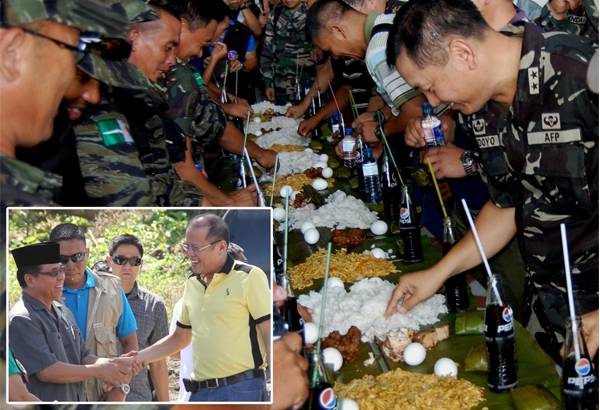'President's visit helped heal wounds between MILF, gov't forces'
- Details

COTABATO CITY, Philippines - Monday’s visit of President Benigno Aquino III at the Moro Islamic Liberation Front’s bastion in northeastern Maguindanao helped start the healing of “old wounds” between government and rebel forces that both bled and suffered from conflicts in decades past.
The hilly surroundings of the Bangsamoro Leadership and Management Institute in Simuay area in Sultan Kudarat town, where Aquino launched, along with MILF chieftain Al-Haj Murad, the “Sajahatra Bangsamoro,” was, in fact, jointly secured by rebels and Army combatants that figured in most battles that rocked the province in recent years.
The president, in a speech, explained that the Sajahatra program is a convergence of education, health, social welfare and other interventions meant to address poverty and underdevelopment in Moro-dominated areas.
Col. Manolito Orense, commander of the Army’s 603rd Brigade, said he never thought the joint security effort for the presidential visit, meant to ward off saboteurs, will have deep, lasting impact on the battle-hardened combatants from both sides that saw each other only in combat situations during the past “hostile years” in Maguindanao.
It was a traditional Philippine military-style “boodle fight,” or free-for-all meal served on a long table, where soldiers and MILF guerillas ate with their bare hands, that sealed the newly established friendship of the supposedly enemy GPH and MILF forces in the province.
The boodle fight, led by Orense and the commander of the Army’s 6th Infantry Division, Major Gen. Caesar Ronnie Ordoyo, was part of the activities during the tactical briefing, a day earlier, for the guerillas and soldiers that were to secure the nearby surroundings of the site of Monday’s presidential speaking engagement.
Gordon Zaipullah, a senior MILF guerilla leader, said the boodle fight was something they never thought would ever happen and bring together enemy forces as if they belong to one big family, dining and relating to one another their optimism on the Mindanao peace process.
“Whenever we see each other before, we shoot each other and try to overcome one another with heavy firepower. Now we are cooperating with each other establish lasting peace in Mindanao,” Zaipullah said.
He said there is a big challenge now for the government and MILF to sustain the unity and cordiality that now binds soldiers and guerillas on the ground.
Zaipullah led some of their bloody counter-attacks on military positions in Central Mindanao in 2000 in response to then President Joseph Estrada’s all out war against the MILF.
Estrada’s military adventurism led to the fall of the MILF’s former bastion, Camp Abubakar Assidik, in the tri-boundaries of Maguindanao’s Buldon, Barira and Matanog towns, and the hoisting of the Philippine flag in most of the guerilla enclaves soldiers overran following heavy offensives that exacted heavy casualties on both sides.
For most peace activists, however, Estrada’s all out war policy against the MILF only intensified Moro dissent and catalyzed the group’s expansion in more areas in Mindanao, including the island provinces of Basilan and Sulu, which are known strongholds of the more moderate Moro National Liberation Front.
Gen. Gilberto Jose Roa, chairman of the government’s Coordinating Community on the Cessation of Hostilities, said there is, thus, much reason for them to rejoice over the improving relations among military units and MILF forces scattered in areas covered by the 1997 Agreement on General Cessation of Hostilities.
Roa and his subordinates in the government’s ceasefire committee all participated in the boodle fight, held at the old Maguindanao provincial capitol compound, only about 500 meters from the venue of Sajahatra’s ceremonial launching.
“This will mean stronger, more comprehensive cooperation in addressing peace and security issues in areas covered by the ceasefire agreement and `zero hostilities’ which is essential in the restoration of normalcy, massive implementation of health, social welfare and other development initiatives in far-flung areas,” said Roa, himself a soldier who saw action in many hostile areas in the south while a junior officer.
Roa said he was delighted hearing from enlisted soldiers, that performed joint security missions for the presidential visit, stories of how their MILF counterparts wished for peace to enable them to till their lands peacefully and send their children to school for them to become responsible professionals.
Soldiers had also shared to their MILF companions how they longed to be together always with their families and how they prayed hard they can return home safely whenever they are deployed to urgent security assignments in combat zones.
“True and noble warriors are always ready to bury their hatchets and reconcile and come to terms beneficial to all. It’s heart rending to see this happening among combatants on the ground. There is tranquil space now, where they can talk to each other and share their visions of peace and development,” Roa said.
There has been a fragile peace in Central Mindanao’s supposedly most dangerous areas for almost two years prior to the Oct. 5, 2012 signing by the government and MILF peace panels of the Framework Agreement on Bangsamoro (FAB) in Malacañang.
The FAB, whose four annexes- territory, wealth-and-power sharing, modalities and transitional arrangements- are now being completed by the GPH and MILF panels, aiming to replace the Autonomous Region in Muslim Mindanao with a new autonomous political entity.
Records obtained from the regional police offices in Region 12 and the Autonomous Region in Muslim Mindanao and the 6th ID indicate a “zero encounter” between government and MILF forces in Central Mindanao in about 18 months before the symbolic crafting of the FAB.
Pocket hostilities that rocked the areas covered by the government-MILF ceasefire pact during the periods only involved feuding rebel groups whose misunderstandings are now being resolved peacefully by the joint ceasefire committee, the local government units, and traditional Moro leaders and clerics wielding influence over the protagonists.

